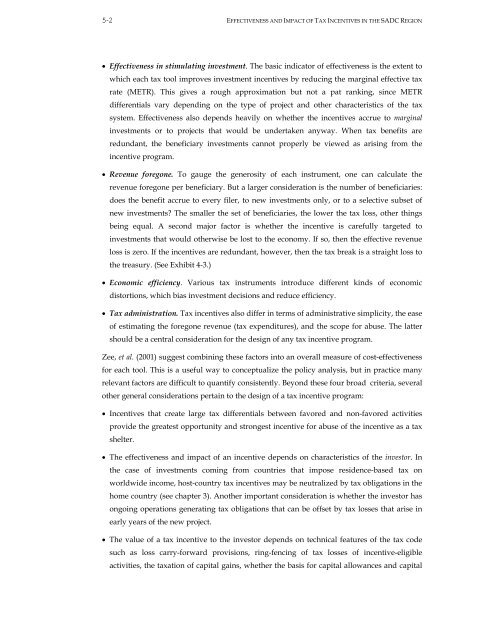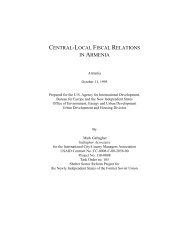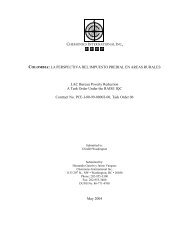Effectiveness and Economic Impact of Tax Incentives in the SADC ...
Effectiveness and Economic Impact of Tax Incentives in the SADC ...
Effectiveness and Economic Impact of Tax Incentives in the SADC ...
You also want an ePaper? Increase the reach of your titles
YUMPU automatically turns print PDFs into web optimized ePapers that Google loves.
5-2 EFFECTIVENESS AND IMPACT OF TAX INCENTIVES IN THE <strong>SADC</strong> REGION<br />
•<br />
•<br />
•<br />
•<br />
•<br />
•<br />
•<br />
<strong>Effectiveness</strong> <strong>in</strong> stimulat<strong>in</strong>g <strong>in</strong>vestment. The basic <strong>in</strong>dicator <strong>of</strong> effectiveness is <strong>the</strong> extent to<br />
which each tax tool improves <strong>in</strong>vestment <strong>in</strong>centives by reduc<strong>in</strong>g <strong>the</strong> marg<strong>in</strong>al effective tax<br />
rate (METR). This gives a rough approximation but not a pat rank<strong>in</strong>g, s<strong>in</strong>ce METR<br />
differentials vary depend<strong>in</strong>g on <strong>the</strong> type <strong>of</strong> project <strong>and</strong> o<strong>the</strong>r characteristics <strong>of</strong> <strong>the</strong> tax<br />
system. <strong>Effectiveness</strong> also depends heavily on whe<strong>the</strong>r <strong>the</strong> <strong>in</strong>centives accrue to marg<strong>in</strong>al<br />
<strong>in</strong>vestments or to projects that would be undertaken anyway. When tax benefits are<br />
redundant, <strong>the</strong> beneficiary <strong>in</strong>vestments cannot properly be viewed as aris<strong>in</strong>g from <strong>the</strong><br />
<strong>in</strong>centive program.<br />
Revenue foregone. To gauge <strong>the</strong> generosity <strong>of</strong> each <strong>in</strong>strument, one can calculate <strong>the</strong><br />
revenue foregone per beneficiary. But a larger consideration is <strong>the</strong> number <strong>of</strong> beneficiaries:<br />
does <strong>the</strong> benefit accrue to every filer, to new <strong>in</strong>vestments only, or to a selective subset <strong>of</strong><br />
new <strong>in</strong>vestments? The smaller <strong>the</strong> set <strong>of</strong> beneficiaries, <strong>the</strong> lower <strong>the</strong> tax loss, o<strong>the</strong>r th<strong>in</strong>gs<br />
be<strong>in</strong>g equal. A second major factor is whe<strong>the</strong>r <strong>the</strong> <strong>in</strong>centive is carefully targeted to<br />
<strong>in</strong>vestments that would o<strong>the</strong>rwise be lost to <strong>the</strong> economy. If so, <strong>the</strong>n <strong>the</strong> effective revenue<br />
loss is zero. If <strong>the</strong> <strong>in</strong>centives are redundant, however, <strong>the</strong>n <strong>the</strong> tax break is a straight loss to<br />
<strong>the</strong> treasury. (See Exhibit 4-3.)<br />
<strong>Economic</strong> efficiency. Various tax <strong>in</strong>struments <strong>in</strong>troduce different k<strong>in</strong>ds <strong>of</strong> economic<br />
distortions, which bias <strong>in</strong>vestment decisions <strong>and</strong> reduce efficiency.<br />
<strong>Tax</strong> adm<strong>in</strong>istration. <strong>Tax</strong> <strong>in</strong>centives also differ <strong>in</strong> terms <strong>of</strong> adm<strong>in</strong>istrative simplicity, <strong>the</strong> ease<br />
<strong>of</strong> estimat<strong>in</strong>g <strong>the</strong> foregone revenue (tax expenditures), <strong>and</strong> <strong>the</strong> scope for abuse. The latter<br />
should be a central consideration for <strong>the</strong> design <strong>of</strong> any tax <strong>in</strong>centive program.<br />
Zee, et al. (2001) suggest comb<strong>in</strong><strong>in</strong>g <strong>the</strong>se factors <strong>in</strong>to an overall measure <strong>of</strong> cost-effectiveness<br />
for each tool. This is a useful way to conceptualize <strong>the</strong> policy analysis, but <strong>in</strong> practice many<br />
relevant factors are difficult to quantify consistently. Beyond <strong>the</strong>se four broad criteria, several<br />
o<strong>the</strong>r general considerations perta<strong>in</strong> to <strong>the</strong> design <strong>of</strong> a tax <strong>in</strong>centive program:<br />
<strong>Incentives</strong> that create large tax differentials between favored <strong>and</strong> non-favored activities<br />
provide <strong>the</strong> greatest opportunity <strong>and</strong> strongest <strong>in</strong>centive for abuse <strong>of</strong> <strong>the</strong> <strong>in</strong>centive as a tax<br />
shelter.<br />
The effectiveness <strong>and</strong> impact <strong>of</strong> an <strong>in</strong>centive depends on characteristics <strong>of</strong> <strong>the</strong> <strong>in</strong>vestor. In<br />
<strong>the</strong> case <strong>of</strong> <strong>in</strong>vestments com<strong>in</strong>g from countries that impose residence-based tax on<br />
worldwide <strong>in</strong>come, host-country tax <strong>in</strong>centives may be neutralized by tax obligations <strong>in</strong> <strong>the</strong><br />
home country (see chapter 3). Ano<strong>the</strong>r important consideration is whe<strong>the</strong>r <strong>the</strong> <strong>in</strong>vestor has<br />
ongo<strong>in</strong>g operations generat<strong>in</strong>g tax obligations that can be <strong>of</strong>fset by tax losses that arise <strong>in</strong><br />
early years <strong>of</strong> <strong>the</strong> new project.<br />
The value <strong>of</strong> a tax <strong>in</strong>centive to <strong>the</strong> <strong>in</strong>vestor depends on technical features <strong>of</strong> <strong>the</strong> tax code<br />
such as loss carry-forward provisions, r<strong>in</strong>g-fenc<strong>in</strong>g <strong>of</strong> tax losses <strong>of</strong> <strong>in</strong>centive-eligible<br />
activities, <strong>the</strong> taxation <strong>of</strong> capital ga<strong>in</strong>s, whe<strong>the</strong>r <strong>the</strong> basis for capital allowances <strong>and</strong> capital











